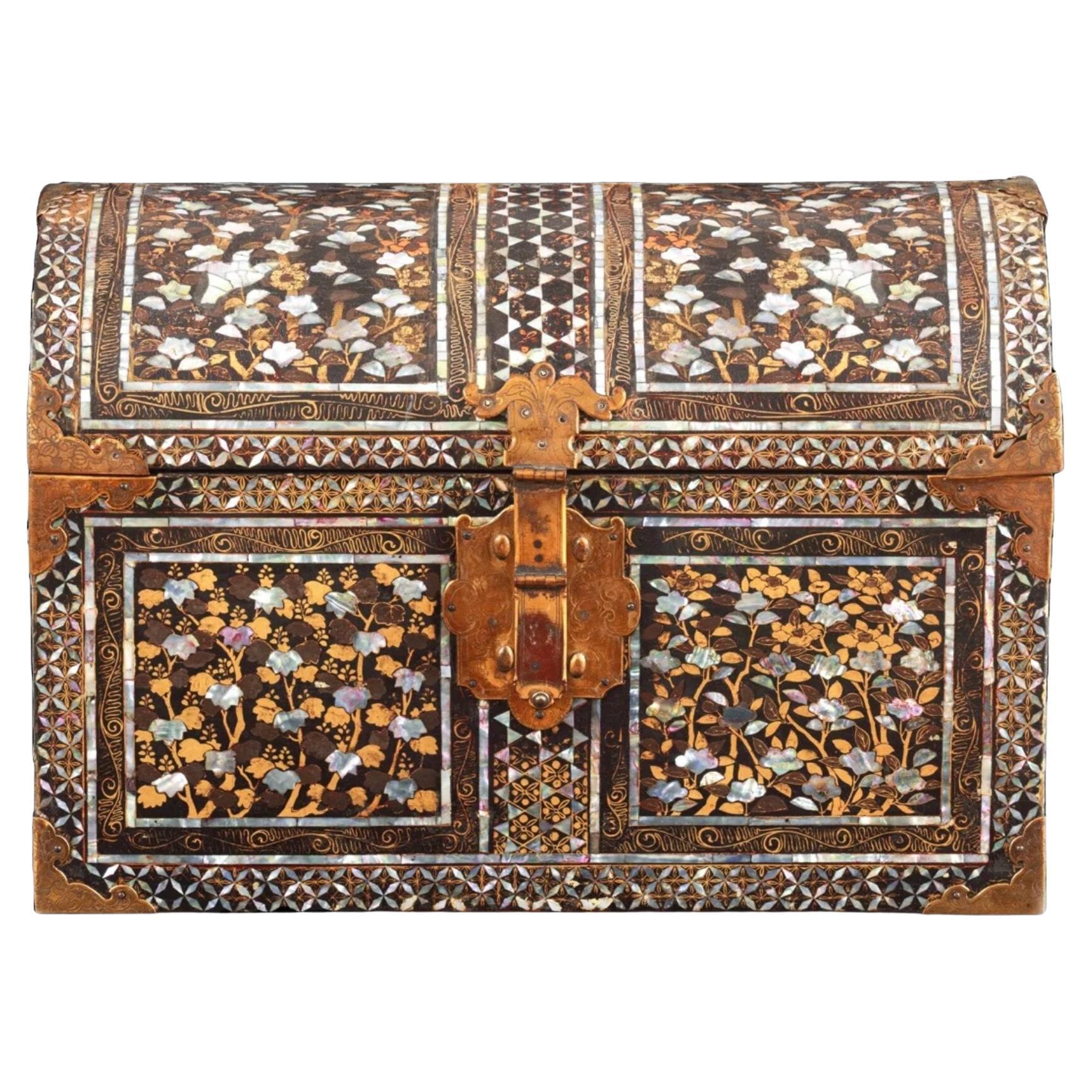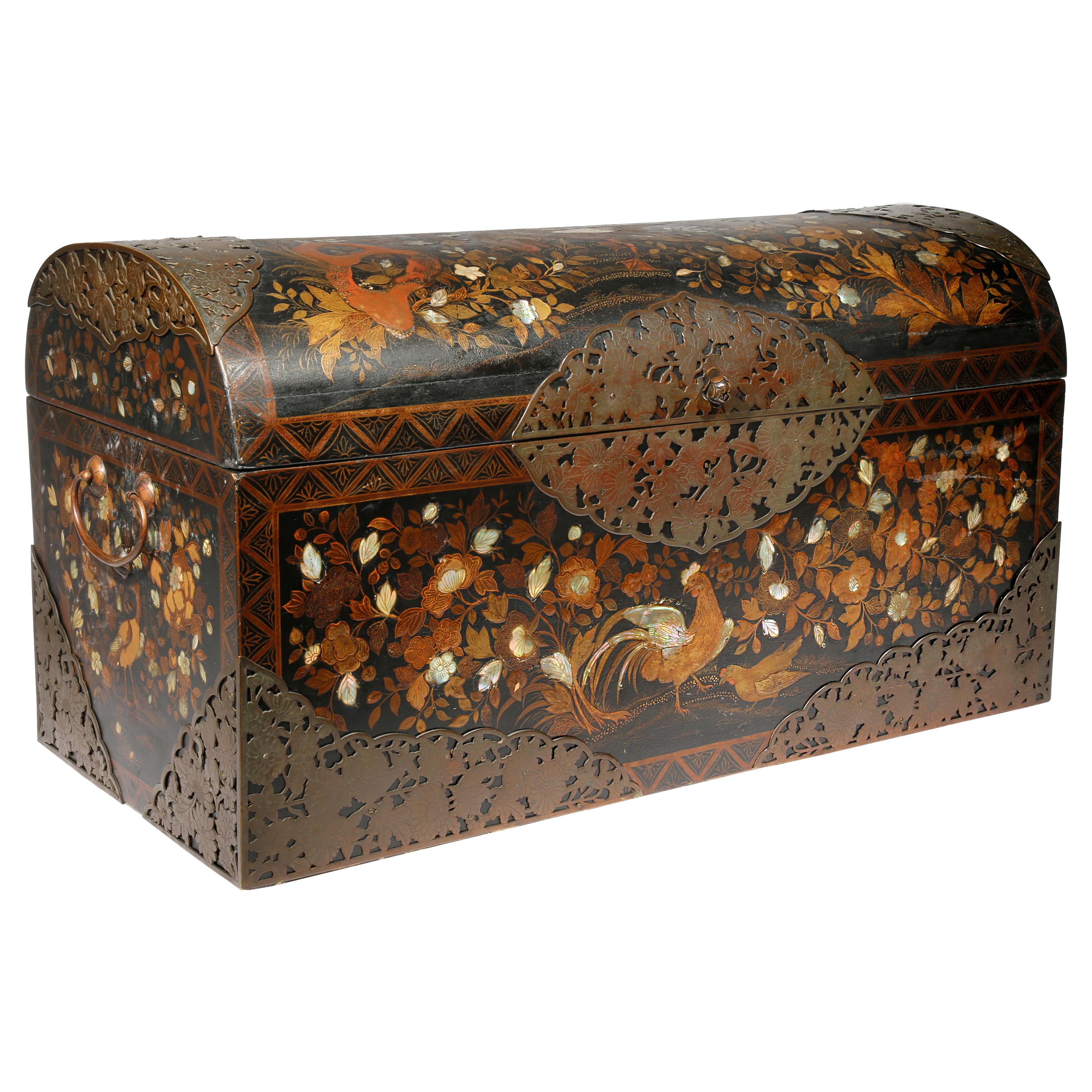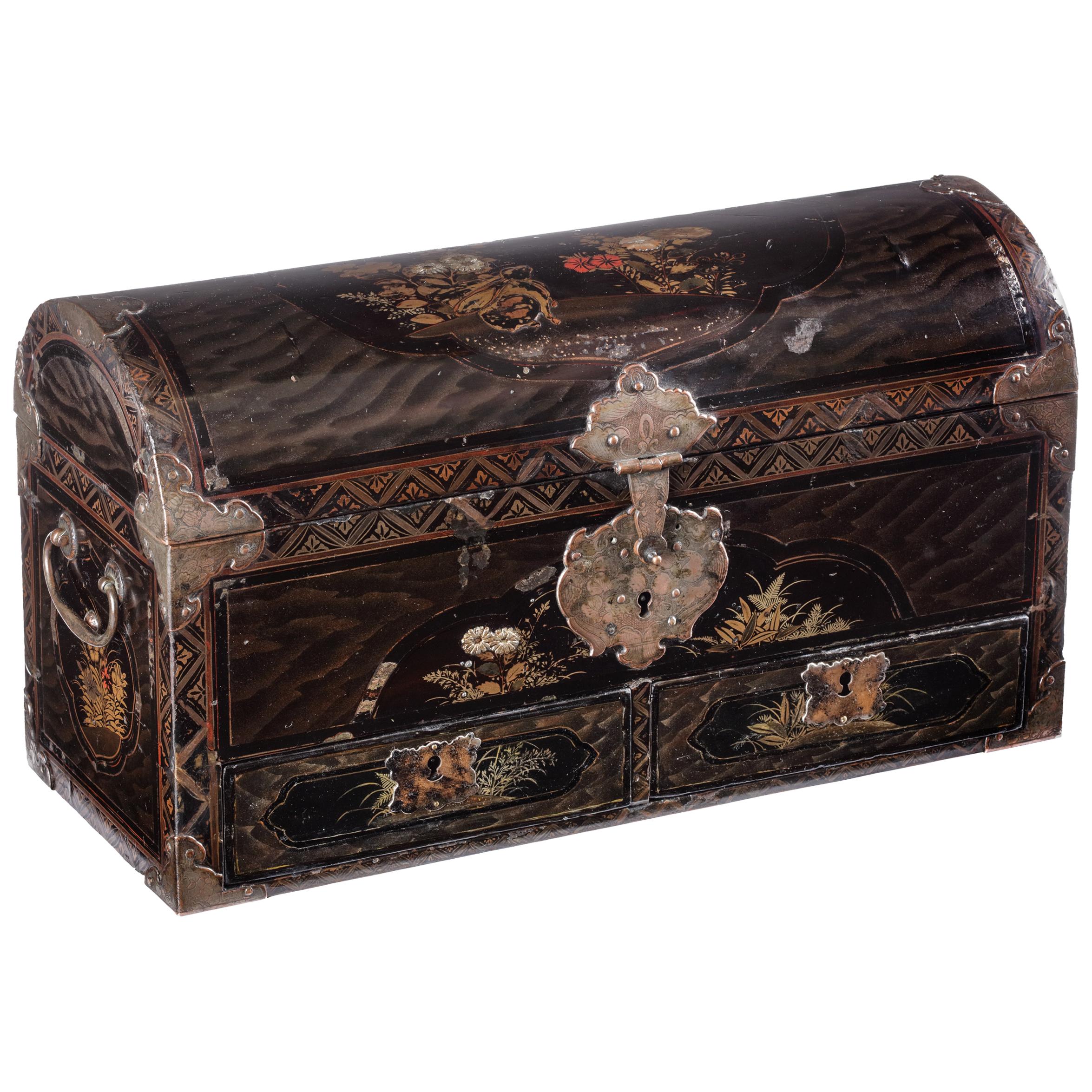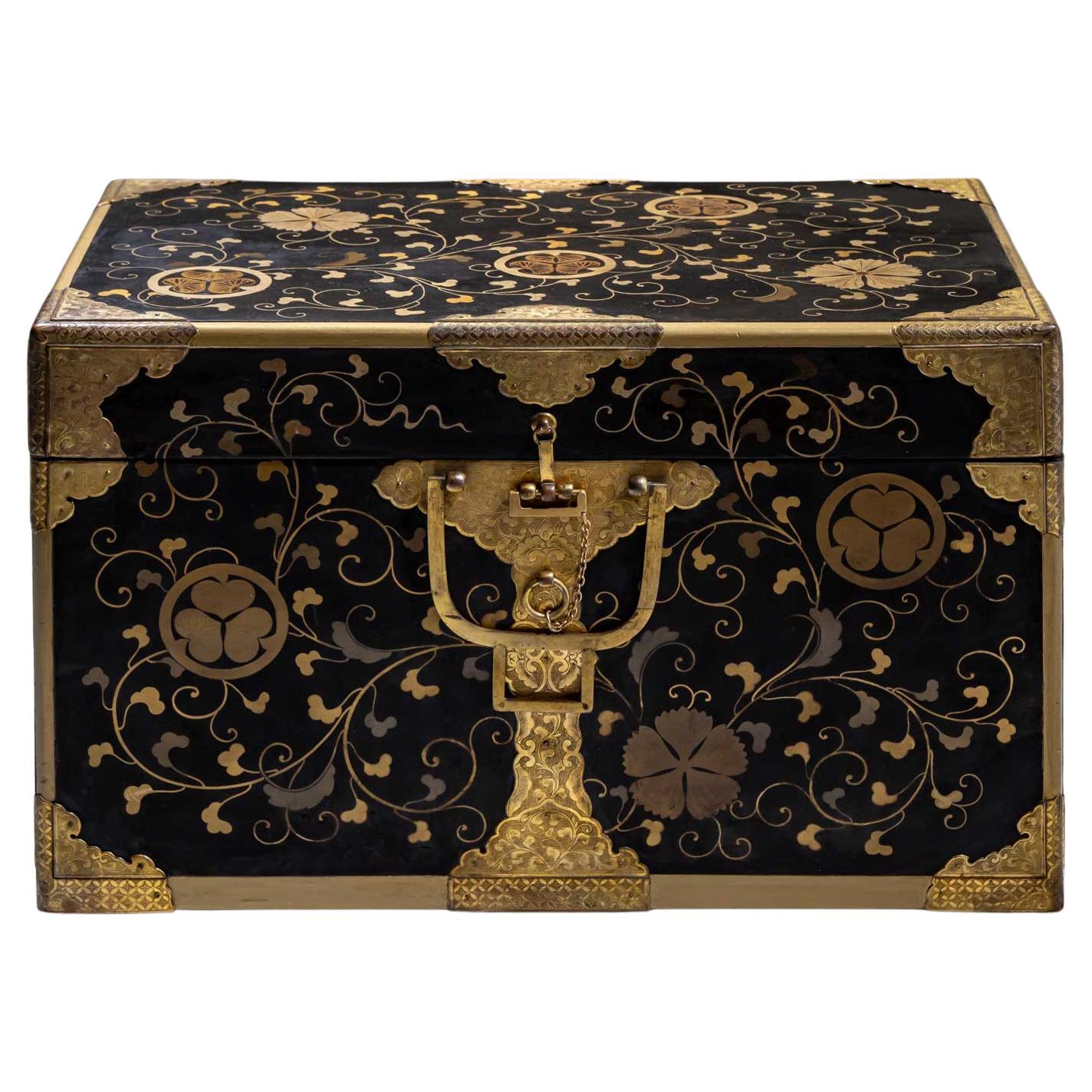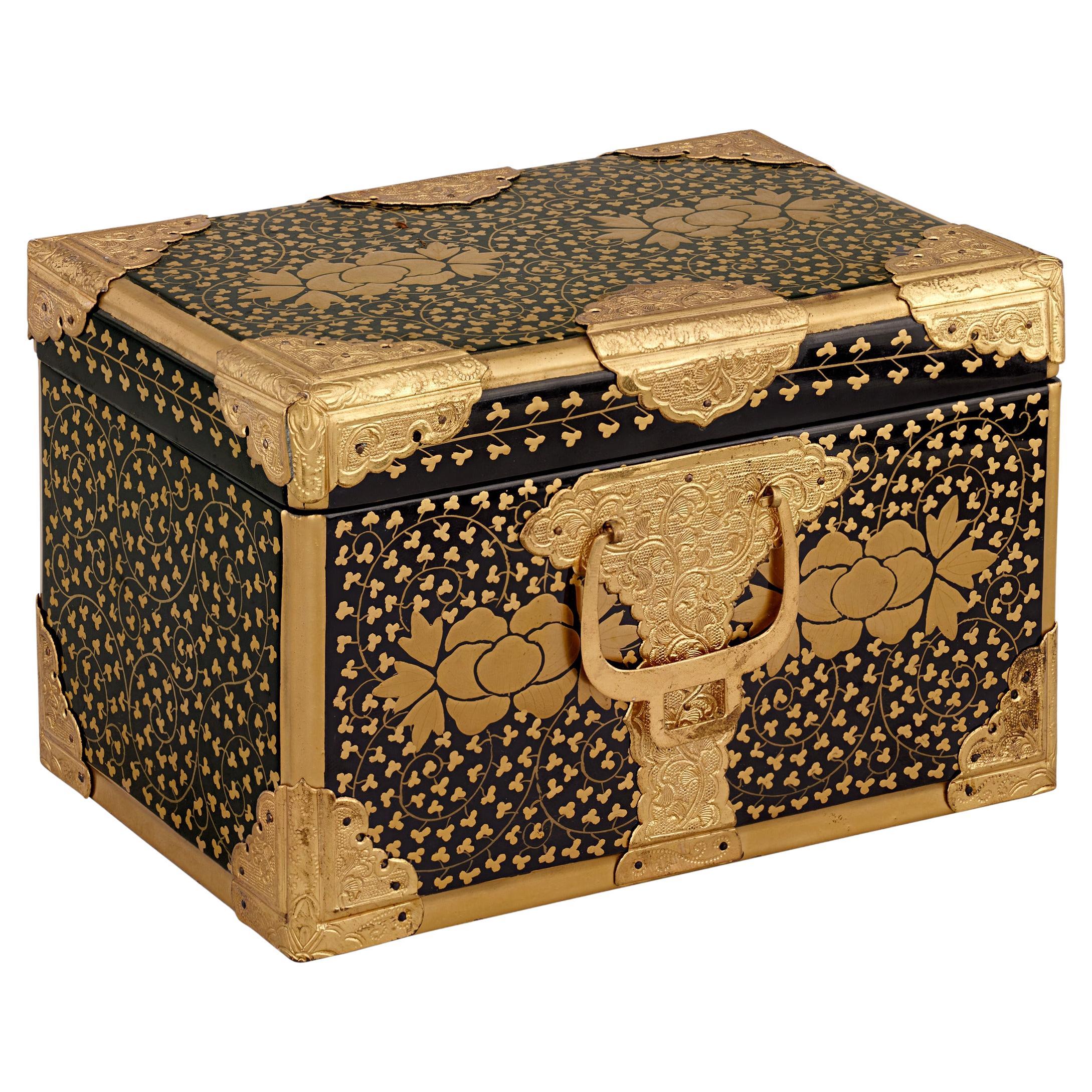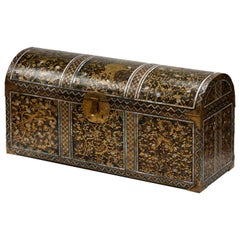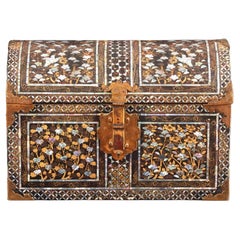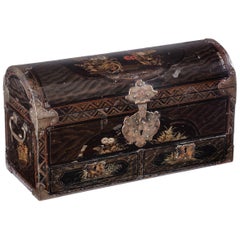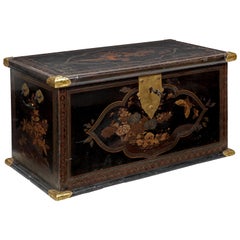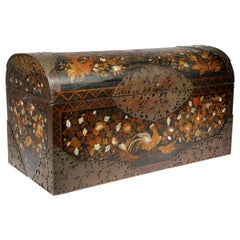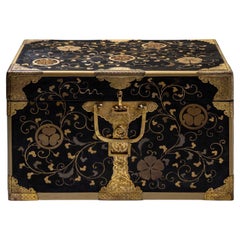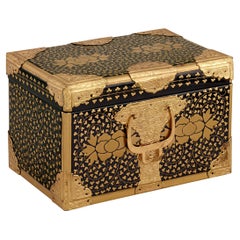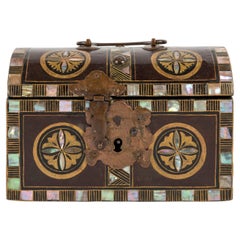Items Similar to A rare Japanese Namban export lacquer coffer with Mon emblems
Want more images or videos?
Request additional images or videos from the seller
1 of 20
A rare Japanese Namban export lacquer coffer with Mon emblems
$66,689.76
£49,910.08
€56,250
CA$92,004.32
A$102,312.63
CHF 53,736.81
MX$1,250,874.53
NOK 669,612.13
SEK 631,263.38
DKK 428,202.94
About the Item
Late Momoyama period, late 16th century
The coffer is decorated in black lacquer, urushi, on cedar wood, decorated with gold dust and silver, maki-e, and nashiji, mother-of-pearl, raden, and red copper mounts in the Kõdaiji-style.
H. 29.2 x W. 45 x D. 38.5 cm
Provenance:
Private collection, the Netherlands
Private collection, Switzerland
Although the form of the box is European/ Iberian, the decoration with several mon that each identify a Japanese family, clan, or individual indicates that this box was probably intended for the Japanese domestic market and not the export market. Mon can be regarded more or less as the Japanese equivalent of the coat-of-arms in European society. The mon possibly originated over a thousand years ago from banners used by warriors on the battlefield in order to distinguish each other. There are 241 different kinds of mon known, but today, with all their variations, about 20.000 exist. In the Edo period, samurai used them to identify themselves, but some particular mon have always been reserved for the Imperial Court.
The mon on the present chest include; Katabami (oxalis), Goshichi-no-kiri (paulownia), Sakura (cherry blossom), Yuroku- kiku (16 petals of chrysanthemum) and Shyppo (the 7 treasures). So most mon consist of stylised flowers.
This coffer was made in the late Momoyama period, the time when Hideyoshi (1537-1598) reigned Japan. He was of peasant ancestry but, nevertheless, became a very powerful general, bringing the ‘Warring States period’ to an
end and unifying Japan. He is also known for crucifying the ‘Twenty-six Martyrs of Japan’ in 1597 to set an example for the Japanese who wanted to convert to Christianity.
- Dimensions:Height: 11.03 in (28 cm)Width: 17.72 in (45 cm)Depth: 15.16 in (38.5 cm)
- Materials and Techniques:
- Place of Origin:
- Period:
- Date of Manufacture:Late 16th century
- Condition:Repaired: Some damages relacquered. Wear consistent with age and use.
- Seller Location:Amsterdam, NL
- Reference Number:1stDibs: LU5458239041132
About the Seller
5.0
Recognized Seller
These prestigious sellers are industry leaders and represent the highest echelon for item quality and design.
Established in 1985
1stDibs seller since 2020
23 sales on 1stDibs
Typical response time: 5 hours
- ShippingRetrieving quote...Shipping from: Amsterdam, Netherlands
- Return Policy
Authenticity Guarantee
In the unlikely event there’s an issue with an item’s authenticity, contact us within 1 year for a full refund. DetailsMoney-Back Guarantee
If your item is not as described, is damaged in transit, or does not arrive, contact us within 7 days for a full refund. Details24-Hour Cancellation
You have a 24-hour grace period in which to reconsider your purchase, with no questions asked.Vetted Professional Sellers
Our world-class sellers must adhere to strict standards for service and quality, maintaining the integrity of our listings.Price-Match Guarantee
If you find that a seller listed the same item for a lower price elsewhere, we’ll match it.Trusted Global Delivery
Our best-in-class carrier network provides specialized shipping options worldwide, including custom delivery.More From This Seller
View AllLarge Japanese Namban Lacquer Coffer Arqueta, 16th Century
Located in Amsterdam, NL
A large Japanese Namban lacquer arqueta coffer for the Portuguese market
Kyoto, Momoyama-period, late 16th century
In Hinoki cypress lacquered in ...
Category
Antique 16th Century Japanese Decorative Boxes
Materials
Mother-of-Pearl, Wood
Superb Late 16th Century Signed Colonial Japanese Namban Export Lacquer Coffer
Located in Amsterdam, NL
Superb late 16th century signed colonial Japanese Namban export lacquer coffer
Momoyama period, late 16th/early 17th century, inscribed 'Arisato' on the bottom
H. 30.5 x W. 43...
Category
Antique 16th Century Japanese Lacquer
Materials
Cedar, Lacquer
Fine Japanese Namban Lacquer Jewelry Casket, 17th Century
Located in Amsterdam, NL
Japanese Namban lacquer transition-style coffer with two drawers
Kyoto/Nagasaki, circa 1650
The cartouches with gilt and red decorations of leaves...
Category
Antique 17th Century Japanese Edo Lacquer
Materials
Cypress
Large Royal Early 17th Century Japanese Lacquer Chest with Gilt-Bronze Mounts
Located in Amsterdam, NL
A large Japanese transitional lacquer chest with gilt-metal mounts
Edo period, early 17th century
The rectangular chest with flat hinged lid decorated in gold, silver, and red ...
Category
Antique Early 17th Century Japanese Blanket Chests
Materials
Bronze
17th-Century Japanese Namban Lacquer Coffer on French Stand, Possibly by Boulle
By André-Charles Boulle
Located in Amsterdam, NL
An impressive and large Japanese 'Namban' transition-style lacquer coffer with fine gilt copper mounts on a French Re´gence base, possibly by André-Charles Boulle (1642-1732)
Kyoto, 1640-1650, the base 18th century
?The coffer with shaped cartouches on a nashiji ground on the lid, front and sides, with fine decorations in various techniques: takimaki-e (high relief), tsuke-gaki (drawing with narrow lacquer lines and over sprinkling with gold and silver), usuniku-takamei-e (demi relief), kimekomi (pushed inside) and accents of kirigane (small geometrical metal mosaics). Inside the cartouche on the lid a landscape with volcanos...
Category
Antique 17th Century Japanese Lacquer
Materials
Brass, Ormolu
An exceptional Namban 'escritório' writing-box, with a single drawer
Located in Amsterdam, NL
Kyoto, Late Momoyama to Edo period, circa 1590-1630
Decorated in pearl shell and gold with branches, leaves and flowers inside cartouches on a pearl shell mosaic background.
H. 25 ...
Category
Antique 17th Century Japanese Lacquer
Materials
Gold
You May Also Like
Japanese Namban Lacquer and Inlay Coffer Momoyama Period
Located in Atlanta, GA
A rare Japanese Namban Lacquer domed coffer circa 1570-1610s of Azuchi-Momoyama to early Edo period. These types of lacquerware were made for export to ...
Category
Antique 16th Century Japanese Japonisme Lacquer
Materials
Wood, Lacquer
Japanese Lacquer Chest, Edo Period
Located in Greding, DE
Small rectangular Japanese chest with gold lacquer decoration in the form of leaf tendrils. The chest is decorated with cut-out and ornamentally engraved fittings on the corners and ...
Category
Antique 18th Century Japanese Edo Decorative Boxes
Materials
Brass
Edo-Period Lacquerware Chest
Located in New Orleans, LA
Edo-Period Lacquerware Chest
19th-century
This exquisite chest, inspired by Hasami-Bako travel trunks, is a striking example of Japanese lacquerware. The hiramaki-e technique—applie...
Category
Antique 19th Century Japanese Edo Decorative Boxes
Materials
Gold
Japanese Namban Chest adorned with cylindrical motives and mother of pearl inlay
Located in PARIS, FR
Small namban style chest with a semi-cylindrical lid made of black lacquered wood (urushi) with gold lacquer (maki-e) and inlaid with mother-of-pearl (raden).
Mon style decoration (...
Category
Antique Mid-18th Century Japanese Lacquer
Materials
Lacquer, Mother-of-Pearl
18th century Chinese hard wood coffer chest
Located in Debenham, Suffolk
Rare 18th century perhaps earlier hard wood coffer, circa 1790.
Presented in original un-restored condition. Original handles and metal work to outer edges.
Lid opens on ringed ha...
Category
Antique Late 18th Century Chinese Qing Decorative Boxes
Materials
Hardwood
Momoyama Namban Chest
Located in PARIS, FR
Namban chest with a semi-cylindrical lid made of black lacquered wood (urushi) with gold lacquer (maki-e) and inlaid with mother-of-pearl (raden).
Decorated with three main bands o...
Category
Antique 17th Century Japanese Antiquities
Materials
Lacquer
$41,495
More Ways To Browse
Red Lacquer Furniture
Black Gold Lacquer
Black And Red Lacquer
Antique Emblems
Antique Furniture Emblems
Red Lacquer Box
Black Lacquer Inlay
Black Japanese Chest
Japanese Samurai Art
Japanese Warrior
16th Century Japanese
Black Lacquer Mother Of Pearl
Red Lacquer Chests
Japanese Export Silver
Lacquer Chest Japan
Copper And Silver Inlay
Asian Black And Gold Decoration
Antique Japanese Silver Box

